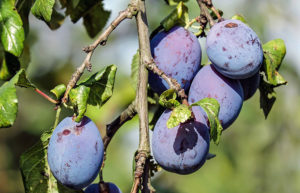What’s a Rootstock? Grafted Fruit Tree Basics
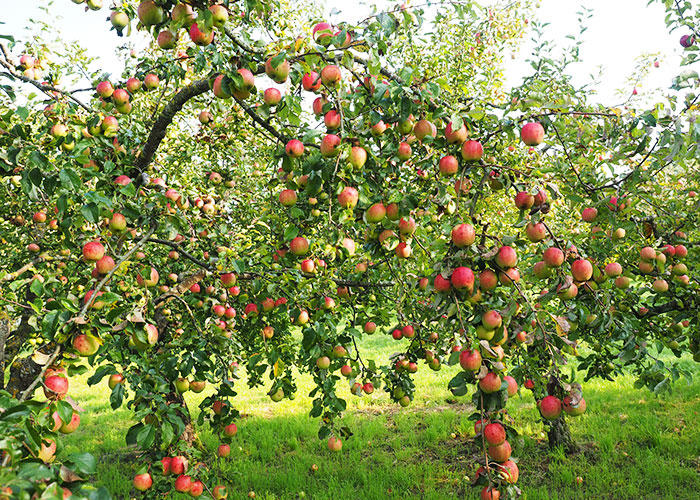
Most of the fruit trees we sell at Sky are grafted, meaning that they are actually a combination of at least two trees! This goes not only for our “combination” trees that grow more than one kind of fruit, but even for those that only produce a single variety. Grafting is what keeps dwarf trees compact (in fact, at this time almost all of our fruit trees are considered dwarf, excluding figs and persimmons), and it also ensures that your trees are as healthy and vigorous as they can possibly be.
If combining several plants into one sounds a little alarmingly futuristic and high-tech, rest assured: people have been grafting plants for thousands of years, and plants have even been known to naturally graft themselves.
Understanding a little bit about the process and purpose of grafting can help you choose the right trees for your needs, and help you take great care of them.
Surprisingly Simple
The ancient art of grafting is much simpler than many people imagine. While there’s certainly finesse to making sure it turns out as planned, the basic procedure is to literally just stick pieces of plants together. Once a person chooses the right starting materials and prepares them correctly, the plants take it from there.
The first grafting experts were plants themselves, and people probably learned the technique from them. Related plants that grow close together and experience some kind of damage or irritation can heal in such a way that they become physically connected. Essentially, they fuse into a single plant.
Humans have learned how to guide this natural grafting process in order to combine closely related plants with different desirable traits. Although no one knows exactly when or where humans first started intentionally grafting plants, evidence suggests that it has been a common practice in China for at least two thousand years, and in the Mediterranian region for over a thousand years.
The Sum of Its Parts
The above-ground part of a grafted tree, aka the part that makes tasty fruit, is called a scion. The scion determines what kind of fruit the grafted plant will produce. In other words, it’s what makes a ‘Granny Smith’ apple a ‘Granny Smith’ and a ‘Bartlett’ pear a ‘Bartlett.’ Scions are made by cutting young shoots from an established tree.
Since most fruit trees won’t come true from seed, propagating them by cuttings is the only way to make sure you’ll get the same tasty fruit from a new tree.
The below-ground part of a grafted tree is called a rootstock. Rootstocks get no say whatsoever in the appearance or taste of the fruit, but they determine a whole host of other characteristics in the final grafted tree such as growth rate and mature size, disease resistance, and tolerance for different kinds of weather.
To attach the scion and rootstock together, a horticulturalist makes a clean, usually notched cut in each piece and secures them together. If all goes well, the two partial plants will grow together into one whole. It’s actually very similar to the way an organ transplant works: just as a heart can be removed from one body to go on beating in another, the rootstock and scion each recognize the other as a missing part that can replace the one they were removed from.
Thanks to the magic of grafting, horticulturalists are able to selectively breed plants for scions and for rootstock separately, then stick the two together to get the best of both worlds. It is even possible to graft more than one scion onto the same rootstock to make a tree that produces several different kinds of fruit (as with the “Fruit Salad” or “Fruit Cocktail” trees we see here at Sky)!
Sky's Rootstocks
Sky’s fruit tree list includes information about each tree’s rootstock along with a description of the fruit itself. But of course, that information is only helpful if you know what it means for you as a gardener! The rootstocks on our trees are chosen not only to keep trees a manageable size for Seattle-area gardens, but also for other excellent qualities such as disease resistance, productivity, and suitability for the Pacific Northwest. Here’s just a little bit about each one:
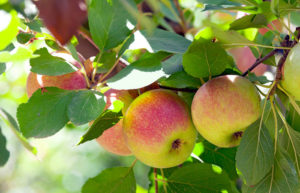 APPLES
APPLES
M27 (mini-dwarf): Considered one of the best rootstocks for trees grown in containers or small spaces, this rootstock keeps trees to no more than 6’ tall. Trees with this rootstock are also very productive for their size, and start producing early in their lives. They are perfect for city gardens, decks, or even patios! Keep in mind that trees grown on this rootstock will need more water, mulch, and staking than those with larger root systems.
M26 (dwarf): This is known as one of the most vigorous dwarfing rootstocks because it results in trees that are very cold-hardy and well-anchored in the soil while only growing 8-12 feet tall. This rootstock also encourages early and prolific production.
MM106 (semi-dwarf): Trees with this rootstock grow to 10-15’ tall, and are very deeply and securely rooted. They will also mature early, produce abundantly, and naturally fend off attacks from wooly aphids. However, they do best in well-drained soil because they can become susceptible to certain diseases in heavy or wet soil.
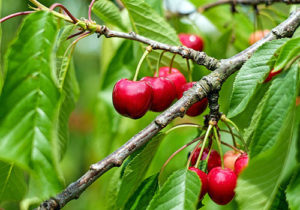 CHERRIES
CHERRIES
Gisela 5 (dwarf): All of our cherries use this rootstock. It produces cherry trees that work well in urban gardens where space tends to be limited, because it keeps the tree no taller than 10 feet tall and helps them produce abundantly for their size. Make sure to provide supplemental water and well-drained soil amended with plenty of compost to help these trees thrive.
PIT FRUITS
(Apricots, nectarines, peaches, and plums)
St. Julian A (dwarf): All of our pit fruits use this root stock because it is very well adapted to Pacific Northwest conditions while also keeping trees to a manageable size. It is very cold-hardy and especially suited to our unpredictable spring weather.
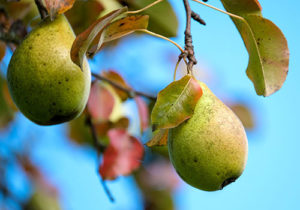 PEARS
PEARS
OHxF87 (semi-dwarf): Pears grown with this rootstock grow to about 85% of the size a tree grown on its own root would. They are known for being very vigorous and heavy-producing, as well as resistant to blight diseases.
OHxF333 (semi dwarf): This is a very disease-resistant, pest-resistant, and adaptable rootstock. It keeps trees to a manageable 12-15 feet tall while supporting excellent health and vigor in all kinds of conditions.
Province Quince (semi dwarf): Known for producing high-yielding, 10-15 foot trees, this rootstock also promotes resistance to some common diseases and tolerance of heavy-wet soils, which are common here in the Pacific Northwest.

